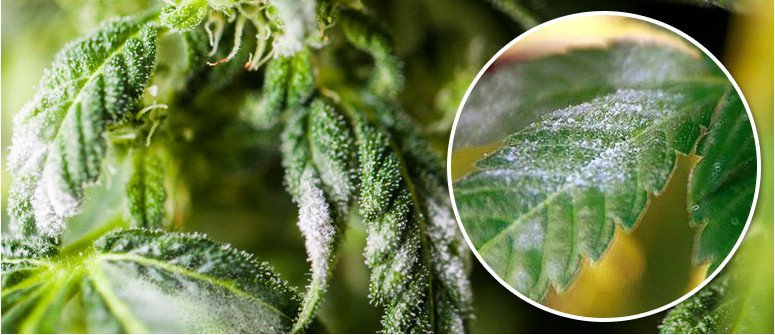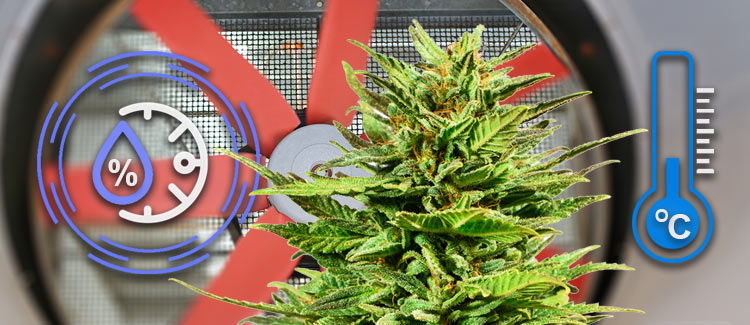Powdery mildew: what is it, how to treat, and how to prevent it

Powdery mildew is a fungal disease. It can affect all kinds of plants, and cannabis growers tend to battle this particular condition pretty regularly.
Cannabis can be affected by all kinds of pests and diseases, and powdery mildew is one of them. Luckily, by knowing a little more about the disease and what causes it, it’s relatively simple to prevent a mildew infection in the future or treat one if it strikes.
WHAT IS POWDERY MILDEW?
Powdery mildew is a fungal disease. It can affect all kinds of plants, and cannabis growers tend to battle this particular condition pretty regularly.
The disease, as the name suggests, will leave plants covered in a fine, white powder that tends to build up on young foliage. First, it will cause the leaves to curl upwards, before eventually causing them to die off completely.
The fungus that is white powdery mildew feeds off this foliage, and over time, it will cause leaves to rot while stunting the growth of the entire plant. In cannabis plants, white powdery mildew can lead to small yields, or even destroy the buds themselves.
In extreme cases, powdery mildew can kill a plant. The fungal spores are also super resilient and can hide out in your garden over long periods of time, striking new plants in the future.
WHAT CAUSES POWDERY MILDEW?
In order for pathogen to attack the plant, its methabolism must be out of balance. In many cases aside from the environment, nutrient imbalance is one of the main reasons for lack of resistance to powdery mildew.
Some of the deficiencies in the feeding regime might be cause due to low levels of available Silicon (S) and Calcium (Ca) which are crucial in structural tissues which play a defensive mechanism to funghi such as powdery mildew. Another reason might be too abundant Nitrogen (N) which can dillute the plant sap making it more suspectible to pathoghens and pests.
Powdery mildew is caused by different species of fungus. These fungi are usually attracted to environments that are too humid or lack proper airflow and ventilation. High humidity is a breeding ground for all kinds of fungi and diseases, and lack of airflow will only make things worse.
If your garden doesn’t get the right kind of airflow, heat and humidity will build up in “pockets” around your plants. These pockets make the perfect place for fungal spores to form and spread.
Crowded gardens are also more susceptible to powdery mildew infections. If foliage from your plants overlaps or touches, it will trap humidity and stale air, creating the ideal environment for fungi. If an infected plant touches another plant, the fungal spores can also spread.
HOW TO BEAT POWDERY MILDEW
Powdery mildew can have devastating effects on your garden, especially if it’s not treated quickly. Luckily, a mildew infection is totally manageable. Here are step-by-step instructions for tackling mildew when it strikes:
1. Clean up affected foliage
Clean up the affected surfaces using high pH water. You want to use water with pH=8.0-8,2 . This will render the surface inhabitable to the funghal spores in the short term future if they wanted to reestabligh a colony.
Start by using paper towels or a clean sponge/cloth and cold water. Whatever you use to wipe down your plants, make sure you dispose of it once you're done. The fungal spores will stick to any material and can spread to other plants around your house or garden.
2. Get pruning if necessary
Using a good pair of gardening secateurs, cut off any dry or yellowing leaves. This helps to redirect your plant's energy, seeing as the affected foliage will only die off anyway. Again, remove any pruned foliage from your garden immediately and dispose of it in order to keep the spores from spreading.
3. Don’t transplant your plants.
The fungal spores will likely just spread to the new soil and you’ll risk infecting other plants in your home or garden. Instead, cover the top layer of your plant’s soil with fresh compost. This will stop the spores from splashing up onto your plants when you water them in the future.
4. Treat your plants and deploy prevention.
Finally, you’ll want to treat your plants with some kind of antifungal agent. Products like Essential oils or Green Cleaner, for example, are great options as they are easy to use. Most fungicides just need to be mixed with water and applied directly to your plants. Alternatively, try treating your plants with neem oil. Just don’t get it on your buds.
HOW TO PREVENT POWDERY MILDEW IN THE FUTURE

If you’ve dealt with powdery mildew before, you’ll know just how much of a pain it is. Hence, you’ll want to do your best to prevent an infection, rather than having to fight one mid-grow.
Luckily, reducing your risk of a mildew infection is easy. Just make sure to keep a close eye on the humidity levels in your garden and ensure the space gets plenty of airflow and ventilation.
The best way to get air moving around a grow space is using fans and a ventilation system. Also, make sure your plants aren’t clustered together and that air is moving all around the entire grow space, especially around the canopy (which is great at trapping hot, humid air).
To control humidity, use a hygrometer and make sure you don’t go above these figures:
- 65–80% for seedlings
- 60–70% for vegetative plants
- 40–55% max for flowering plants
- 35–45% in the final 2 weeks before harvest
Remember, while powdery mildew is a tough disease; it usually won’t strike just because your humidity is a little off. It often takes a deadly combination of poor airflow, poor ventilation, and hot, humid conditions in order for the fungal spores to form and spread.
POWDERY MILDEW ISN’T THE ONLY MOLD TO LOOK OUT FOR
Powdery mildew is a common fungal pathogen, but there are others to keep an eye out for too. Damp environments with little airflow will breed a variety of different fungi that can damage plant health.
BUD ROT
Botrytis, or bud rot, is another common fungal infection. This mold is initially hard to detect, but makes itself apparent as sugar leaves begin to discolor and dry out. These signs usually occur right at the base of sugar leaves where they meet the bud. Left untreated, bud rot will result in large dead spots on flowers and fluffy white growths. To avoid encountering this annoyance, keep relative humidity under 50% and leave fans running to provide good airflow. If you detect bud rot, it’s important to remove affected buds right away to prevent it from spreading.
FUSARIUM
Fusarium is a soil-borne fungal disease that is particularly hard to detect and get rid of. This pathogen causes wilting, stunted growth, root and stem rot, and reddening of the xylem (water-carrying vessels in the stem).
Fusarium eventually obstructs the xylem and prevents water from being delivered to leaves and flowers above the blockage. This leads to wilting and the eventual death of the plant. It’s easy to see how this fungus can wreck havoc on a cannabis crop. As well as being lethal, Fusarium is notoriously hard to get rid of. The fungus can lay dormant in the soil for long periods of time, emerging during hot weather.
If you notice the above symptoms, it’s likely you're dealing with this culprit. It’s devastating, but the only way forward is to remove and destroy affected plants as soon as possible. You’ll also have to avoid using this section of your garden for the foreseeable future. Fusarium-infected soil should be left to rest for at least 4–5 years before being used again. The other option is to remove the soil and replace it with fresh earth.
SOOTY MOLDS
Sooty molds are a type of fungus that can infect cannabis plants after they’ve been attacked by pests. They start to infest after insects bore into leaves and expose plant sap. These types of mold don’t directly attack plants, but they can still be problematic. Excessive growth can block out light and prevent photosynthesis.
Sooty mold gets its name from its close resemblance to the dark black substance found in fireplaces. This kind of fungus can also appear dark brown. Early growth will appear as a fine layer of powder, but will develop into a thick sheet if left unchecked. It can affect plants all year round, and is particularly prolific during pest infestation.
Sooty molds can be tackled without the use of chemicals. Wiping leaves or spraying them with lukewarm water is enough to get rid of the infection for a while. The fungus may come back in time, but water is enough to keep it at bay periodically before harvesting.
PYTHIUM
Pythium is a genus of fungi that includes over 150 species. Some of them are free-living in the soil and harmless to cannabis plants. Others are pathogenic and infect animals, plants, and fungi alike. Pythium fungi can cause considerable damage to plants in the seedling stage.
Often referred to as root rot, Pythium is a parasite that lurks in the rhizosphere. Its natural habitat makes it considerably hard to detect. Brown discoloration near the roots, a foul smell, and wilting and collapsing plants are telltale signs.
Pythium thrives when overwatering occurs. Giving your plants too much H₂O constructs the perfect environment for mold: excess moisture and lack of air. To prevent Pythium from setting in, only water your plant when the top inch of soil is dry.




